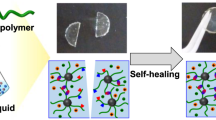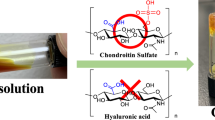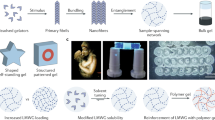Abstract
The study of supramolecular gels has developed into a well-recognised field of materials science, pertaining to the general area of soft matter. The use of small molecules that aggregate through supramolecular interactions (such as hydrogen bonds, π–π interactions, coordination bonds and van der Waals interactions) has given materials scientists an alternative to polymeric compounds for the development of practical gels. There have been further attempts to functionalize, activate or control the physical properties of such gels by means of the reversibility of the interactions between the component molecules. Tuning of these characteristics has been accomplished by using mechanical, thermal, electrochemical, electromagnetic and chemical stimuli. The use of anions as a chemical stimulus has been a recent development and is the subject of this Perspective.
This is a preview of subscription content, access via your institution
Access options
Subscribe to this journal
Receive 12 print issues and online access
$259.00 per year
only $21.58 per issue
Buy this article
- Purchase on Springer Link
- Instant access to full article PDF
Prices may be subject to local taxes which are calculated during checkout




Similar content being viewed by others
References
Hirst, A. R., Escuder, B., Miravet, J. F. & Smith, D. K. High-tech applications of self-assembling supramolecular nanostructured gel-phase materials: from regenerative medicine to electronic devices. Angew. Chem. Int. Ed. 47, 8002–8018 (2008).
Terech, P. & Weiss, R. G. Low molecular mass gelators of organic liquids and the properties of their gels. Chem. Rev. 97, 3133–3160 (1997).
Fages, F. (ed.) Low molecular mass gelators: Design, self-assembly, function. Top. Curr. Chem. 256 (special issue), 1–273 (Springer, 2005).
Ishi-i, T. & Shinkai, S. Dye-based organogels: stimuli-responsive soft materials based on one-dimensional self-assembling aromatic dyes. Top. Curr. Chem. 258, 119–160 (2005).
Estroff, L. A. & Hamilton, A. D. Water gelation by small organic molecules. Chem. Rev. 104, 1201–1218 (2004).
van Esch, J. H. & Feringa, B. L. New functional materials based on self-assembling organogels: from serendipity towards design. Angew. Chem. Int. Ed. 39, 2263–2266 (2000).
Sangeetha, N. M. & Maitra, U. Supramolecular gels: functions and uses. Chem. Soc. Rev. 34, 821–836 (2005).
Weiss, R. G. & Terech, P. (eds) Molecular Gels: Materials with Self-Assembled Fibrillar Networks (Kluwer Academic, 2005).
Naota, T. & Koori, H. Molecules that assemble by sound: an application to the instant gelation of stable organic fluids. J. Am. Chem. Soc. 127, 9324–9325 (2005).
Anderson, K. M. et al. Structure calculation of an elastic hydrogel from sonication of rigid small molecule components. Angew. Chem. Int. Ed. 47, 1058–1062 (2008).
Chung, J. W., An, B.-K. & Park, S. Y. A thermoreversible and proton-induced gel-sol phase transition with remarkable fluorescence variation. Chem. Mater. 20, 6750–6755 (2008).
Sugiyasu, K., Fujita, N., Takeuchi, M., Yamada, S. & Shinkai, S. Proton-sensitive fluorescent organogels. Org. Biomol. Chem. 1, 895–899 (2003).
Sako, Y. & Takaguchi, Y. A photo-responsive hydrogelator having gluconamides at its peripheral branches. Org. Biomol. Chem. 6, 3843–3847 (2008).
Ghoussoub, A. & Lehn, J.-M. Dynamic sol-gel interconversion by reversible cation binding and release in G-quartet-based supramolecular polymers. Chem. Commun. 5763–5765 (2005).
Zhang, Y., Gu, H., Yang, Z. & Xu, B. Supramolecular hydrogels respond to ligand-receptor interaction. J. Am. Chem. Soc. 125, 13680–13681 (2003).
Bhuniya, S. & Kim, B. H. An insulin-sensing sugar-based fluorescent hydrogel. Chem. Commun. 1842–1844 (2006).
Sreenivasachary, N. & Lehn, J.-M. Gelation-driven component selection in the generation of constitutional dynamic hydrogels based on guanine-quartet formation. Proc. Natl Acad. Sci. USA 102, 5938–5943 (2005).
Fages, F. Metal coordination to assist molecular gelation. Angew. Chem. Int. Ed. 45, 1680–1682 (2006).
Maeda, H. Anion-responsive supramolecular gels. Chem. Eur. J. 14, 11274–11282 (2008).
Sessler, J. L., Gale, P. A. & Cho, W.-S. Anion Receptor Chemistry (Royal Society of Chemistry, Cambridge, 2006).
Yamanaka, M., Nakamura, T., Nakagawa, T. & Itagaki, H. Reversible sol-gel transition of a tris-urea gelator that responds to chemical stimuli. Tetrahedron Lett. 48, 8990–8993 (2007).
Stanley, C. E. et al. Anion binding inhibition of the formation of a helical organogel. Chem. Commun. 3199–3201 (2006).
Maeda, H., Haketa, Y. & Nakanishi, T. Aryl-substituted C3-bridged oligopyrroles as anion receptors for formation of supramolecular organogels. J. Am. Chem. Soc. 129, 13661–13674 (2007).
Wang, C., Zhang, D. & Zhu, D. A chiral low-molecular-weight gelator based on binaphthalene with two urea moieties: modulation of the CD spectrum after gel formation. Langmuir 23, 1478–1482 (2007).
Maeda, H. Supramolecular chemistry of acyclic oligopyrroles. Eur. J. Org. Chem. 5313–5325 (2007).
Webb, J. E. A., Crossley, M. J., Turner, P. & Thordarson, P. Pyromellitamide aggregates and their response to anion stimuli. J. Am. Chem. Soc. 129, 7155–7162 (2007).
Kim, T. H. et al. Gelation-induced fluorescence enhancement of benzoxazole-based organogel and its naked-eye fluoride detection. Chem. Commun. 2364–2366 (2008).
Džolić, Z., Cametti, M., Cort, A. D., Mandolini, L. & Žinić, M. Fluoride-responsive organogelator based on oxalamide-derived anthraquinone. Chem. Commun. 3535–3537 (2007).
Yang, H. et al. Switchable fluorescent organogels and mesomorphic superstructure based on naphthalene derivatives. Langmuir 23, 8224–8230 (2007).
Varghese, R., George, S. J. & Ajayaghosh A. Anion induced modulation of self-assembly and optical properties in urea end-capped oligo(p-phenylenevinylene)s. Chem. Commun. 593–595 (2005).
Wang, S., Shen, W., Feng Y. & Tian, H. A multiple switching bisthienylethene and its photochromic fluorescent organogelator. Chem. Commun. 1497–1499 (2006).
Piepenbrock, M.-O. M., Lloyd, G. O., Clarke, N. & Steed, J. W., Gelation is crucially dependent on functional group orientation and may be tuned by anion binding. Chem. Commun. 2644–2646 (2008).
Zhang, J., Xu, X. & James, S. L. Solution state coordination polymers featuring wormlike macroscopic structures and cage-polymer interconversions. Chem. Commun. 4218–4220 (2006).
Becker, T. et al. Proline-functionalised calix[4]arene: an anion-triggered hydrogelator. Chem. Commun. 3900–3902 (2008).
Yang, Z. et al. Enzymatic formation of supramolecular hydrogels. Adv. Mater. 16, 1440–1444 (2004).
Yang, Z., Gu, H., Zhang, Y., Wang, L. & Xu, B. Small molecule hydrogels based on a class of antiinflammatory agents. Chem. Commun. 208–209 (2004).
Curr. Opin. Colloid Interface Sci. 9 (special issues on Hofmeister effects), 1–197 (2004).
Kim, H.-J., Zin, W.-C. & Lee, M. Anion-directed self-assembly of coordination polymer into tunable secondary structures. J. Am. Chem. Soc. 126, 7009–7014 (2004).
Kim, H.-J., Lee, J.-H. & Lee, M. Stimuli-responsive gels from reversible coordination polymers. Angew. Chem. Int. Ed. 44, 5810–5814 (2005).
Leontidis, E. Hofmeister anion effects on surfactant self-assembly and the formation of mesoporous solids. Curr. Opin. Colloid Interface Sci. 7, 81–91 (2002).
Weng, W., Beck, J. B., Jamieson, A. M. & Rowan, S. J. Understanding the mechanism of gelation and stimuli-responsive nature of a class of metallo-supramolecular gels. J. Am. Chem. Soc. 128, 11663–11672 (2006).
Liu, Q., Wang, Y., Li, W. & Wu, L. Structural characterization and chemical response of a Ag-coordinated supramolecular gel. Langmuir 23, 8217–8223 (2007).
Kishimura, A., Yamashita, T. & Aida, T. Phosphorescent organogels via “metallophilic” interactions for reversible RGB-color switching. J. Am. Chem. Soc. 127, 179–183 (2005).
Henstock, H. An investigation into the causes of gel formation by some organic salts in methanol solution. J. Am. Chem. Soc. 61, 670–673 (1939).
Abdallah, D. J. & Weiss, R. G. The influence of the cationic center, anion, and chain length of tetra-n-alkylammonium and –phosphonium salt gelators on the properties of their thermally reversible organogels. Chem. Mater. 12, 406–413 (2000).
Trivedi, D. R. & Dastidar, P. Cation-induced supramolecular isomerism in the hydrogen-bonded network of secondary ammonium monocarboxylate salts: a new class of organo gelator and their structures. Cryst. Growth Des. 6, 2114–2121 (2006).
Ballabh, A., Trivedi, D. R. & Dastidar, P. New series of organogelators derived from a combinatorial library of primary ammonium monocarboxylate salts. Chem. Mater. 18, 3795–3800 (2006).
Acknowledgements
We thank the Commonwealth Scholarships Commission and the EPSRC for funding of our work in the fascinating world of supramolecular gels.
Author information
Authors and Affiliations
Corresponding author
Rights and permissions
About this article
Cite this article
Lloyd, G., Steed, J. Anion-tuning of supramolecular gel properties. Nature Chem 1, 437–442 (2009). https://doi.org/10.1038/nchem.283
Published:
Issue Date:
DOI: https://doi.org/10.1038/nchem.283
This article is cited by
-
Deep Learning Method to Accelerate Discovery of Hybrid Polymer-Graphene Composites
Scientific Reports (2021)
-
The Physical Chemistry for the Self-assembly of Peptide Hydrogels
Chinese Journal of Polymer Science (2018)
-
The Metal Effect on Self-Assembling of Oxalamide Gelators Explored by Mass Spectrometry and DFT Calculations
Journal of the American Society for Mass Spectrometry (2018)
-
Synthesis and gelation capability of mono- and disubstituted cyclo(L-Glu-L-Glu) derivatives with tyramine, tyrosine and phenylalanine
Colloid and Polymer Science (2017)
-
Permeation and optical properties of YAG:Er3+ fiber membrane scintillators prepared by novel sol–gel/electrospinning method
Journal of Sol-Gel Science and Technology (2017)



